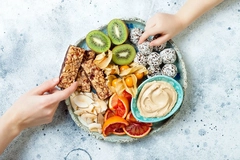Shelf-stable: Expert body highlights the role of additives for food safety amid COVID-19
06 Apr 2020 --- Despite the challenges posed by coronavirus, the International Food Additives Council (IFAC) is highlighting that the safety and quality of the global food supply remains strong, and that food additives continue to play a vital role in maintaining the quality of foods in the home pantry.
As previously reported by FoodIngredientsFirst, there has been a rise in kitchen cupboard staple products such as rice, flours, lentils, grains and bakery ingredients. In this spirit, food additives can ensure food products remain shelf-stable, extend product shelf life, and allow consumers to stock up on food products without fear of immediate expiration.

While there have been isolated reports of shortages of certain food products on a retail level, which are primarily due to transportation and restocking issues as well as panic buying earlier on in the coronavirus outbreak, IFAC maintains that COVID-19 has not had an impact on food safety. According to the US Food and Drug Administration (FDA) and the European Food Safety Authority (EFSA), there is no evidence of COVID-19 transmission through food or food packaging, including imported goods such as food and drugs for animals and pets. There have also been no cases of COVID-19 in the US, associated with imported goods, the IFAC flags.
During this challenging time, consumers are often minimizing their time in stores and supermarkets, but also stocking up on food and packaged foods containing food additives is a viable solution. In addition to contributing to taste, texture, freshness and the overall appearance of food, food additives contribute to product stability and shelf life, IFAC highlights.
There are several important food additive classifications which contribute to product stability:
Preservatives help extend the life of foods and prevent spoilage. Preservatives also help foods maintain their appearance, taste and texture. Preservatives are found in a variety of foods including jellies, cereals, oils and baked goods.
Preservatives come in many different forms. For example, sugar, salt and vinegar are often used to delay the growth of bacteria in foods. Antioxidants help reduce oxidation in foods, increasing shelf life and preventing spoilage and phosphates are used to help preserve processed meat and poultry products.
Emulsifiers, stabilizers and thickeners are all common food additives which help maintain the appearance of foods while preserving freshness and quality. Emulsifiers help to prevent oil and water mixtures from separating within a product. They are found in a variety of foods, including margarine, ice cream, bread, chocolate and some processed meats. Mono- and diglycerides of fatty acids are a common example of an emulsifier that disperses fat in foods to allow it to become more water-soluble. They can also help reduce food waste by keeping foods mixed.
Stabilizers help ingredients stay dispersed and suspended in a product solution. Stabilizers are commonly used in beverages – such as fruit and vegetable juices – as well as liquid infant formula. Some common stabilizers include gellan gum and carrageenan.
Thickeners enhance the texture of foods and can give low fat or reduced calorie foods the texture of full fat/calorie options. Xanthan gum is a common thickener and can even be purchased in grocery stores.
Firming agents help foods maintain their crisp quality and strength. They are also commonly used to help prolong shelf life. Firming agents are used in a variety of foods including canned meats, pickles, fruits and vegetables. Sodium citrate, also known as citric acid, is a common firming agent derived from citrus fruit.
Edited by Elizabeth Green












